Mark Sisson's Blog, page 289
August 25, 2014
Dear Mark: Dealing with Undersleeping, and the Nutritional Value of Yeast
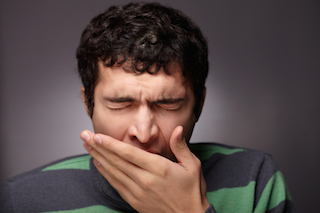 For today’s edition of Dear Mark, we’ve got two questions. First up is a big one: how do you deal with the inevitable bout of acute sleep loss? Are there pills to take, exercises to do or avoid, foods to eat or not? Or are we completely helpless in the face of undersleeping? And second, I discuss the importance – or not – of yeast in the diet. Are we missing out on an integral part of the human diet by avoiding the yeast found in bread?
For today’s edition of Dear Mark, we’ve got two questions. First up is a big one: how do you deal with the inevitable bout of acute sleep loss? Are there pills to take, exercises to do or avoid, foods to eat or not? Or are we completely helpless in the face of undersleeping? And second, I discuss the importance – or not – of yeast in the diet. Are we missing out on an integral part of the human diet by avoiding the yeast found in bread?
Let’s find out:
Hi Mark
We all agree that getting enough sleep is important on all levels, and a good sleeping routine is vital to ensuring a good night’s sleep. However, what can we do when sleep deprivation cannot be helped – e.g. new mothers, sudden stress induced insomnia, deadlines, travel etc. – to help ourselves the day following such sleeplessness to counteract the bad effects/generally help us get through the day (without getting into a sleepless cycle, i.e. too much coffee)? Should we attempt to sleep in? Should we take more supplements that day? Eat more primal carbs? Take naps? Take the day off from exercise? Or exercise to induce fatigue? No strength training but cardio is ok? Go to bed earlier? Would really appreciate your thoughts on how to deal with “undersleeping”. Thank you!
Azira
Great question. Sleep deprivation is sometimes unavoidable, but we don’t want it to totally undermine our efforts to be healthy. By identifying the specific and known health effects of sleep deprivation, we can propose physiologically plausible solutions or temporary workarounds. A 2010 review of the endocrine effects of sleep deprivation on humans provides a good overview:
Glucose tolerance goes down. This is a well-known phenomenon, and it’s probably one reason why chronic sleep loss is a big risk factor for diabetes.
Solution: Avoid unnecessary carbohydrates. The more intolerant you are to carbs, the more body fat you’ll gain when you eat them. The day after bad sleep should be lower carb than a day after good sleep.
Appetite increases. Leptin, the hormone that signals satiety, is lowest in people with sleep debt. In a cruel twist of fate, people who haven’t slept tend to crave carbohydrates and junk food more than any other food. Their ability to resist these cravings also decreases.
Solution: “Don’t eat so much” doesn’t really work for most people, especially if your body is telling you to eat as much as possible. Some of us can simply go without and be fine, but others have this weird inability to easily ignore the body’s physiological impulses. If you feel like snacking, try pistachios. The little green nuts improved glucose metabolism and insulin resistance in a recent randomized controlled trial. Anything with cinnamon is also good, since the spice improves insulin sensitivity following a bad night’s sleep.
Cortisol rhythm grows discordant. Normally, cortisol is highest in the morning (to wake you up) and drops through the day until the evening, when it’s lowest (to let you get to sleep). Under sleep debt, cortisol is still high in the morning, but the drop-off throughout the day is far more gradual – and at night, cortisol remains elevated enough to disrupt the quality sleep you so desperately need.
Solution: There are several things you can do throughout the day to help normalize your cortisol levels.
Meditate, especially at night before bed. Meditation has a remarkable stultifying effect on cortisol.
Eat your carbs at night. Carbohydrate can lower cortisol in the short term but sleep loss has made you glucose intolerant, so limit your carbs to night.
Go easy on the exercise. Walk, don’t run; walking lowers cortisol. Even better, go walk through a forest, a park, the beach, or anywhere out in nature for even more cortisol reduction. If you lift, keep the volume low. Go for singles and doubles instead of sets of 12. If you promised your buddy you’d run hill sprints with him, make them super short – like 3 or 4 seconds long.
Don’t not eat. Fasting will probably just exacerbate the sleep deprivation stress you’re experiencing. Stick to protein, fat, and limit (but don’t eliminate) the carbs.
Your blood pressure goes up. When you haven’t slept, your body is on high alert. The sympathetic nervous system kicks in, your pulse pounds, you’re all sweaty and disoriented in this alternate reality you’ve stumbled into, and your blood pressure spikes. That explains the “tired but wired” zombie-esque head space we’ve all felt after a bad night of sleep.
Solution: Get some bright light and sun, but not too much strong sun (a disrupted circadian rhythm also increases your skin’s susceptibility to UV damage). However, sun exposure does release nitric oxide, which lowers blood pressure. It’s also calming, soothing, and just plain enjoyable.
Balance decreases. A night of sleep deprivation disrupts your postural control. In one study, sleep deprived adults had a harder time maintaining their balance; excessive swaying was evident.
Solution: Avoid workouts involving complex exercises requiring coordination between multiple body parts. Stick to simpler exercises, like walking, cycling, pushups, or pullups. Bodyweight stuff. Don’t go for a PR in the snatch today, yeah? You probably won’t hit it and you might hurt yourself.
Intestinal permeability increases. Your gut becomes more leaky after a bad night’s sleep, allowing passage of unwanted and/or harmful irritants, allergens, bacteria, and endotoxins from your gut to your bloodstream.
Solution: Limit foods to which you suspect you’re intolerant. Suspect you have an issue with gluten? Don’t test your luck with a pizza cheat day if you haven’t slept much.
Oh, I almost forgot:
Take a nap. Naps after a bad night’s sleep are exquisite. They’re perhaps my favorite pastime (that I don’t get to do as often as I’d like). It’s going to bed and dropping into the abyss of deep inevitable sleep, except you get to do it twice. Once during the day, once at night. Oh, and naps (even a ten minute nap) are pretty good at helping you recover alertness after sleep deprivation (PDF). They take the edge off.
I’d like to make an important point: if we’re talking a bad night’s sleep every once in awhile, the above recommendations will help and might even mitigate most of the short term issues. But acute sleep loss, while bad, isn’t the real problem. It’s eating a high carb, high junk food diet while getting five hours a night for months on end. It’s going to bed at midnight and waking up for the 5 AM CrossFit class every other day. It’s staying up until 2 AM watching bad TV and eating your weight in gluten. It’s chronic sleep loss/deprivation that’s truly dangerous. These strategies may keep the negative health effects initially, but not for long. Don’t take today’s post as a free pass to skip sleep. It will catch up to you.
Hi Mark,
We already established that mushrooms are beneficial to our health. I was wondering what really is the purpose of yeast – the yeast people make bread with – which is a fungi in the same kingdom as mushrooms.
Are we missing out on yeast in the Primal [Blueprint] diet because we don’t eat bread?
Can you advise if you consider it primal and how can we get it or try to get it in our diet?
Thank You and Kind Regards
Dee
Good question. I’ve got good news. Yeast is everywhere. If you’re eating real produce, it’ll have live, active yeast – as long as it hasn’t been subjected to major industrial washing. The blackberries you got at the farmer’s market? Teeming with yeast.
Natural yeast allows fermentation. It’s the natural yeasts and bacteria on cabbage that allow sauerkraut and kimchi. The wild yeasts on grapes allow wine (although most modern vintners add certain dependable species back in after washing the grapes). Both beer brewers, winemakers, and bread bakers use yeasts from the same species: Saccharomyces cerevisiae. Brewer’s yeast is a popular nutritional supplement, too. A couple tablespoons contains:
1.2 mg thiamine (80% of daily value)
1.5 mg riboflavin (90%)
10 mg niacin (50%)
0.8 mg vitamin B6 (40%)
80 mcg folate (15%)
1 mg copper (50%)
63 mcg selenium (90%)
633 mg potassium (18%)
16 grams protein
That’s not bad. It’s also a good source of chromium, a trace mineral that may help insulin resistant people improve glucose tolerance. If you’re really interested in getting baker’s yeast, you can get pretty close by eating brewer’s yeast.
It’s not totally benign, of course. Many people find that they simply cannot tolerate concentrated dietary sources of yeasts (like bread, alcohol, or straight tablespoons of supplemental yeast). A recent study found that hidradentis suppurativa patients are more likely to be sensitive to brewer’s/baker’s yeast and experience fewer symptoms when yeasts are eliminated from the diet.
Bottom line: There are nutritional benefits to baker’s/brewer’s yeast, especially in people who avoid animal products, but a piece of bread isn’t giving you enough yeast to make a difference. To make bread, bakers typically add just a teaspoon of yeast to over a pound of flour. Good luck getting enough yeast to make a dent in your nutrient requirements from bread alone.
You’re not missing much. And if you were, you could just drink a glass of wine with yeast bits floating around or take brewer’s yeast. No need for bread.
Thanks for writing in and reading, everyone!
Like This Blog Post? Dig Deeper with Primal Blueprint Books and Learn How You Can Reprogram Your Genes to Become Leaner, Stronger and Healthier




August 24, 2014
Weekend Link Love – Edition 310
 I did a few podcasts recently. First, I talked about the basics of Primal living on the Low Carb Paleo Show. I also chatted with Sam Feltham of Smash the Fat and Chris Martenson of the Peak Prosperity podcast about the primacy of diet in determining our health and genetic destiny.
I did a few podcasts recently. First, I talked about the basics of Primal living on the Low Carb Paleo Show. I also chatted with Sam Feltham of Smash the Fat and Chris Martenson of the Peak Prosperity podcast about the primacy of diet in determining our health and genetic destiny.
Research of the Week
Long term (5 year) ketosis has no negative effect on bone density and body composition in adults with GLUT-1 deficiency.
Those fMRI studies should be taken with a grain of salt. Active neurons don’t always show increased blood flow.
Yep, extra virgin olive oil is still really good for you. A new study finds that it increases antioxidant levels in healthy humans.
Eight weeks of hatha yoga improves memory and quick thinking.
Interesting Blog Posts
We are puppets whose masters demand unmodified potato starch as tribute.
Yes, the previous link was satire.
A man recounts his 30 days spent eating Soylent, the liquid “superfood.”
The evolutionary context of ketosis in humans.
Media, Schmedia
Look at all the polysyllabic ingredients in these natural foods.
NBA players are really getting serious about their food (and cutting unnecessary carbs in the off-season).
This guy didn’t fare as well on his liquid diet as the guy I mentioned above.
Everything Else
The recently passed, arguably greatest squash player to ever live learned to play the sport in bare feet.
I’m not sure what this means for the politics of Primal Blueprinters.
Select Whole Foods locations are beginning to roll out rabbit meat, and rabbit activists (yep, those exist) are up in arms.
Now let’s try this for the human zoo.
Is it bad that I find this dystopian vision of the future slightly believable?
Recipe Corner
Simple to make but impressive to those who weren’t there for the preparation: lamb boulettes.
It’s fig season, so go grab some kale, some walnuts, some prosciutto and make kale salad with figs, walnuts, and prosciutto.
Time Capsule
One year ago (Aug 24 – Aug 30)
The Power of Giving: What We Get When We Give – You might even say that giving is a selfish act!
How I Recover From My Workouts – Recovering from a workout is just as important as the workout itself. Here’s how I do it.
Comment of the Week
Leslie,
I had a big one too. One day a woman at the park commented on his portly size and asked, “What size diapers does he wear?” I replied, “He does not wear diapers, he wears Petite Depends.”
- Excellent response to a nosey interloper.
Like This Blog Post? Dig Deeper with Primal Blueprint Books and Learn How You Can Reprogram Your Genes to Become Leaner, Stronger and Healthier




August 23, 2014
Tomato and Eggplant Gratin
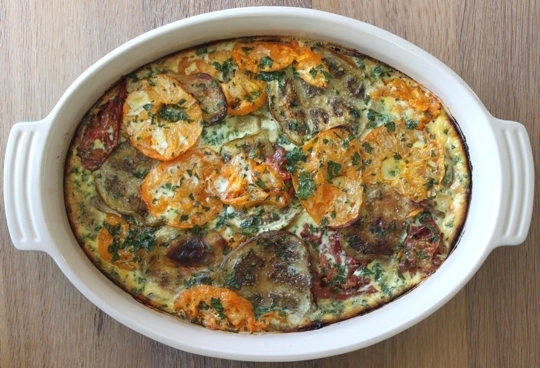 If you want a beautiful side dish to set on the table, this tomato and eggplant gratin is it. Especially when made with colorful heirloom tomatoes. It tastes rich and decadent but is actually quite healthy when you take into account the antioxidants from the tomatoes and eggplant, potential health benefits of full fat dairy and protein from eggs.
If you want a beautiful side dish to set on the table, this tomato and eggplant gratin is it. Especially when made with colorful heirloom tomatoes. It tastes rich and decadent but is actually quite healthy when you take into account the antioxidants from the tomatoes and eggplant, potential health benefits of full fat dairy and protein from eggs.
Did you know that eggplant has high levels potent antioxidants? And as most people know, so do tomatoes. Healthwise and flavorwise they make a good team. But enough about all the healthy stuff. Plain and simple, this tomato and eggplant gratin is delicious. Really, delicious. Make it in the summer with perfectly ripe heirloom tomatoes or make it in the winter and serve it as a holiday side dish.
Servings: 6
Time in the Kitchen: 2 hours
Ingredients:
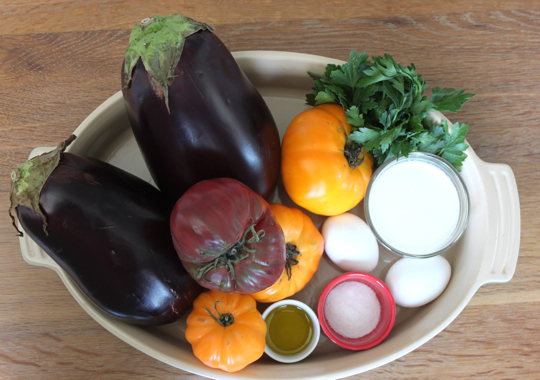
2 eggplants, peeled (optional) and sliced into rounds 1/4-inch thick (6 mm)
2 tablespoons (30 ml) plus 1/2 teaspoon (2.5 ml) kosher salt, divided
2 pounds tomatoes, thinly sliced (900 g)
1/2 cup olive oil (120 ml)
2 eggs
1 cup heavy cream (240 ml)
1/4 cup finely chopped parsley (60 ml)
Instructions:
Preheat an oven to 375 °F/190 °C.
In a large bowl, dissolve 2 tablespoons (30 ml) salt in 1 cup (240 ml) warm water. Once the salt is dissolved, put the eggplant slices in the salt water. Add enough cool water to cover the eggplant, 4 to 6 cups. (950 ml to 1420 ml) .Set a plate that is slightly smaller than the top of the bowl on the eggplant pieces to keep them submerged in the water. Let sit for 30 minutes. (Brining eggplant removes bitterness and keeps the texture from turning dry and leathery when roasted or grilled.)
While the eggplant is soaking, place the tomato slices on a baking sheet lined with parchment paper (to prevent sticking) and drizzle lightly with olive oil. Roast for 20 to 25 minutes. The tomatoes should release most of their moisture and become soft and shriveled. Take the tomatoes out, let cool, and set aside.
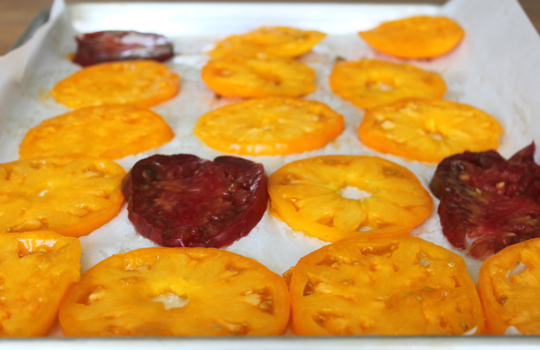
Drain the eggplant and pat thoroughly dry.
Lay the eggplant slices out evenly on baking sheets and lightly brush with olive oil on both sides. You’ll probably use around 1/2 cup of olive oil to do this. Roast until the eggplant is soft, 30 minutes.
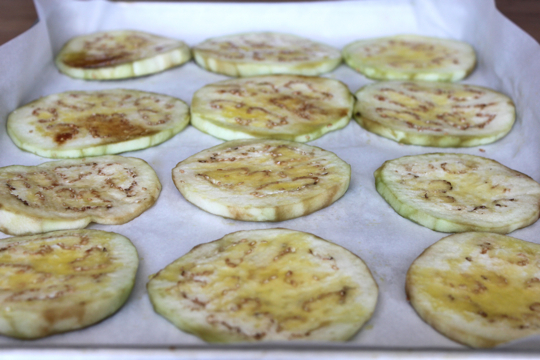
In a large oval (or 9×13 cake pan) layer the eggplant and tomato.

Whisk together eggs, cream, parsley and remaining 1/2 teaspoon salt.
Pour the custard on top of the tomato and eggplant.
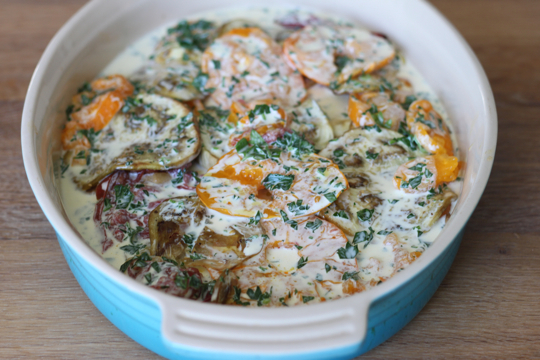
Bake 30 to 35 minutes until the custard is set and lightly browned.
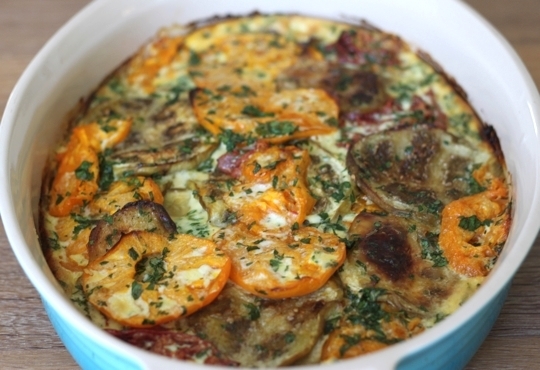
Not Sure What to Eat? Get the Primal Blueprint Meal Plan for Shopping Lists and Recipes Delivered Directly to Your Inbox Each Week




August 22, 2014
It Was Time to Change: 228 Pounds Lost and Lifelong Dreams Realized
It’s Friday, everyone! And that means another Primal Blueprint Real Life Story from a Mark’s Daily Apple reader. If you have your own success story and would like to share it with me and the Mark’s Daily Apple community please contact me here. I’ll continue to publish these each Friday as long as they keep coming in. Thank you for reading!
 I have been morbidly obese practically my entire life. By the time I was 10 years old, I was a chubby kid, weighing in at over 100 pounds. I was in size 44 pants by the time I was in high school and kept going up from there. In November 2010, I weighed 440 pounds (200 kg). I was morbidly obese, lacked confidence, and when it came to my own life, I lived in constant fear that I was having a heart attack every time I was short of breath. I had discretely (and without doctor’s orders) started taking aspirin daily because I knew it was only a matter of time before I followed in the footsteps of almost every other male in my family and had a heart attack. I suffered from massive acid reflux, which also was a source of heart disease fears, and I was pre-diabetic and had constant pain in my joints and lower back.
I have been morbidly obese practically my entire life. By the time I was 10 years old, I was a chubby kid, weighing in at over 100 pounds. I was in size 44 pants by the time I was in high school and kept going up from there. In November 2010, I weighed 440 pounds (200 kg). I was morbidly obese, lacked confidence, and when it came to my own life, I lived in constant fear that I was having a heart attack every time I was short of breath. I had discretely (and without doctor’s orders) started taking aspirin daily because I knew it was only a matter of time before I followed in the footsteps of almost every other male in my family and had a heart attack. I suffered from massive acid reflux, which also was a source of heart disease fears, and I was pre-diabetic and had constant pain in my joints and lower back.
I had made the decision to medicate my downward spiraling health and not treat it. Moreover, my food addiction was getting worse by the day. I was spending about $500 per month on fast food and another $200 per month on convenience store garbage, like donuts, bagels, and sugar filled soda. I would never choose to abstain from a food because it was terrible for my health, and I never even considered doing exercise for the purpose of fitness, but I was getting to the stage where even getting out of the car was a cardio workout.
I was in pain being on my feet any longer than 15 minutes. This made my job difficult (where I am required to do presentations and networking in social settings) and any time I received an invitation from friends, I had to think about if I’d be able to make it through the activity. I wore ankle braces every day because my body was struggling just to hold my weight, and was forced to buy whatever clothes I could find that could fit me due to a diminishing selection at my growing size.

I privately wondered:
Could anyone ever love me (myself included) as obese as I was? How long would it be before my loved ones would start to be ashamed of me? Were they already? Will I live to see my daughters graduate, marry, and be adults?
On the outside, I wasn’t an unhappy person. In fact, a majority of people around me seemed to like me and think I was a positive, happy person, but inside I was just living day to day. I had settled in life, love, and was not long for this world.
It was at this time that I had an epiphany moment. While pondering a church lesson about mistreating my body, I finally saw that I had gotten out of control. That I was miserable and in pain, and that I deserved to live, for the first time in my life, without all of these problems. I had tried to lose weight so many times before, but for the first time, I decided to do it for me. My daughters deserved the best version of me and I deserved to be that man. See, I had never even considered the fact until that very moment, that food and my addiction to it was hurting my relationships, shortening my life unnecessarily, damaging the quality of my life, and taking away from those that I loved most.
It was time to change.
The next morning, I decided to get outside and go for a walk. It was 4am. When I returned home after what was probably a quarter of a mile, I was breathing so hard that my roommate thought I was having a heart attack. But I didn’t die. And that told me I could probably do it again tomorrow, and I might not die then either.
At first, I had a good friend write me up some meal plans, but found myself bored with the plans and started to research diet and nutrition. It was at this point that I came across the Paleo diet. I love to research and I started to listen to podcasts by Robb Wolf and Chris Kresser and purchased Robb’s book and used tons of recipes from EverydayPaleo.com and Mark’s Daily Apple.
Some people have asked me if I struggle with the restrictive nature of an elimination diet, but as a recovering junk food addict, the structure of the Paleo approach was exactly what I needed to stay on track. Having a framework to stay within gave me boundaries to re-establish a healthy relationship with food. Prior to this, food was my security blanket and BFF. We celebrated together. We mourned together. We hung out on dates and business meetings and get togethers. Food was always there with and for me.
Going Paleo gave me an opportunity to reexamine my relationship with food and focus on nutrient dense products. The weight started to pour off of me. The pre-diabetes went away and my joints stopped hurting. My acid reflux was gone completely and has not returned. I was switching products every six months when one would stop working, and now I was completely off medication. My sleep improved and my pants started to loosen.
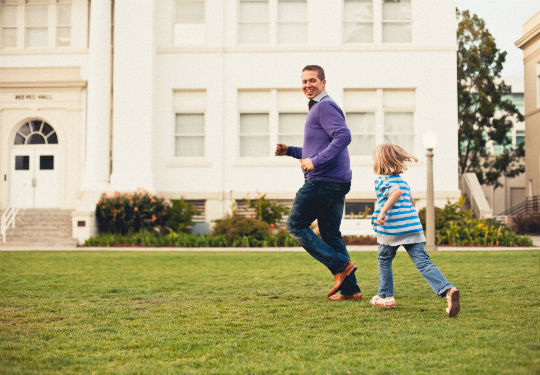
After nine months, I started some additional strength training and increased my protein intake to facilitate muscle growth. Essentially, I started focusing on the compound lifts and made great progress with a linear progression system.
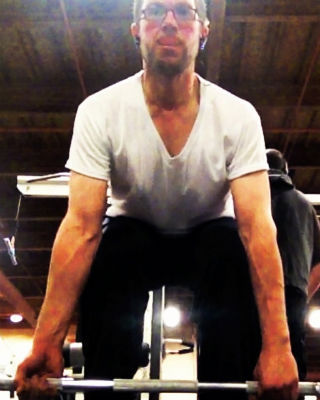 When I first made my decision to lose weight, my friend Bret dropped in my mind the thought that I could actually drop 100 pounds by the next Christmas (a year and a month away). When I first started eating healthily, the weight poured off of me. It’s clear to me now that my body wanted to be fit and I had been fighting it my whole life with my addiction. Despite hitting a few plateaus along the way, by the following Christmas, I had almost hit my initial goal weight. In fact, in just one year and nine days, I had lost 200 pounds on the nose. That’s right, I lost 200 pounds in a year without pills, shakes, or surgery: eating the foods I loved and established, for the first time in my life, a healthy relationship with food.
When I first made my decision to lose weight, my friend Bret dropped in my mind the thought that I could actually drop 100 pounds by the next Christmas (a year and a month away). When I first started eating healthily, the weight poured off of me. It’s clear to me now that my body wanted to be fit and I had been fighting it my whole life with my addiction. Despite hitting a few plateaus along the way, by the following Christmas, I had almost hit my initial goal weight. In fact, in just one year and nine days, I had lost 200 pounds on the nose. That’s right, I lost 200 pounds in a year without pills, shakes, or surgery: eating the foods I loved and established, for the first time in my life, a healthy relationship with food.
On Thanksgiving, I ran in my first 5K and my entire family was there cheering me on at the finish line and inside I knew that I had become the man they would always know: healthy, strong, and happy. Loved by others always, but finally by himself.
On the 18-month anniversary of my weight loss journey, I participated in the Wildflower Triathlon, and although it was too far away for my family to attend, I was surrounded by some supportive friends and proudly finished the race.
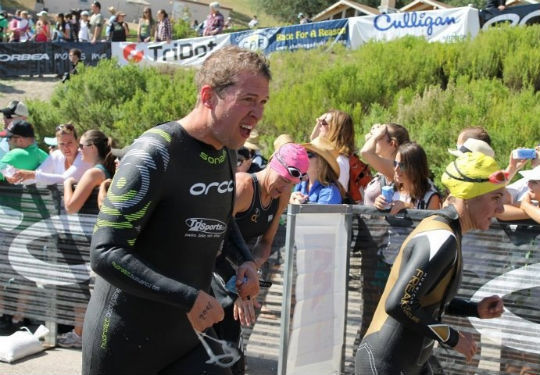
Paleo worked so well for me for a few reasons:
Consistency – Paleo gave me a framework on how and what to eat, which is exactly what a recovering junk food addict needs. Also, I had a linear training program that allowed me to systematize my fitness as well.
No “Cheat Days” – I love the way Robb has said that your diet is not a marriage. You can’t cheat on it. This has helped me to learn that if I want to eat something, I need to change the way I see it. I am still 100% gluten free and have been since day 1 of Paleo. I don’t miss the foods because I love the way I feel.
I did it for me. This was the click that changed this time. See, this was not the first time I’d attempted a change, but this is the first time it stuck (I’ve been at my goal weight for over two years now). Every other time, I did it for a girl or a suit or some other reason. This time I did it because I realized that I deserved to be healthy and happy and I deserved to live.
Did I have some external motivation? Of course. I was concerned that relationships had deteriorated due to my poor health. I like the attention that comes from the opposite sex now. I love being strong in and out of the gym. I get a rush from completing a new personal best or when I did my triathlon.
I love not having limits. I work for a construction company in marketing (I don’t actually do construction) so when a homeowner for the first time offered for me to go on a ladder and check out the damage in his attic, I said yes. The truth was that I don’t know enough about construction to actually know what I was seeing, but I was just excited to be able to climb a ladder for the first time in my life and walk around up there because a couple of years before, no one would have in their right mind invited me to climb anything.
In closing, please allow me to present the tale of the tape:
Weight: 440 pounds to 212 pounds = 228 pounds lost or over 50% of my body weight. I’ve also added some of muscle weight to this. Waist: 56 inch to 33 inch = 23 inches lost. Neck: 22 inch to 16 inch = 6 inches lost. Shirt Size: 4X to a Large Collarbone: I now have one (or two? I failed anatomy). Adam’s Apple: Finally. Visible Vascularity: About time. Fitness: I couldn’t walk to I feel physically fit for the first time in my life.
In short, I could say that Paleo made me the man I’ve dreamt of becoming my whole life: the man hiding inside that other one that I used to be and I couldn’t be happier.
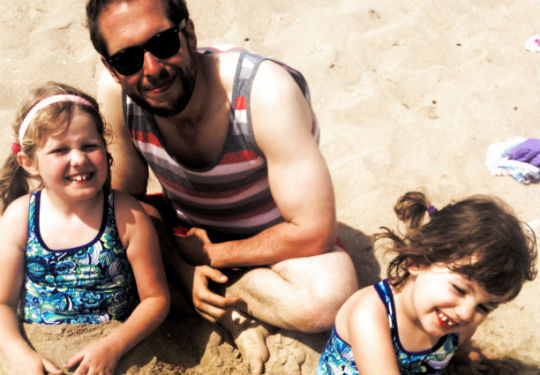
Not Sure What to Eat? Get the Primal Blueprint Meal Plan for Shopping Lists and Recipes Delivered Directly to Your Inbox Each Week




August 21, 2014
Why We Eat: Hunger
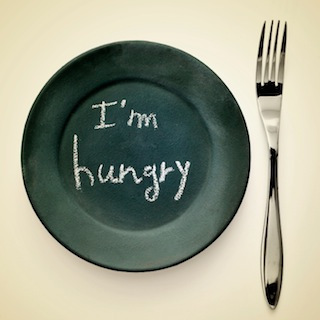 It sounds like the question of a 4-year-old making his first forays into understanding life, biology, and the nature of the universe: “Mom, why do we eat?” On some level, there’s an answer that’s both basic and true – the kind with which we’d respond to little Junior: “We eat because we’re hungry.” If it – and we – were only that simple…. Beyond the hormonal cues that tell us our bodies need feeding exists an intricate constellation of reasons. They stem from the gamut of higher order thinking, social reference and self-organization that characterize the human mind. And just when you thought the biological picture was at least an easy call, it’s important to note the environmental inputs that can skew our hormonal responses and convince us we need to raid the refrigerator at midnight. (Yes, analyzing human instinct can feel like nailing Jello to the wall.) So, what are the various reasons we eat? What influenced your food intake today? Truth be told, sometimes we’re not even conscious of our simplest motivations. I thought I’d take up the multifaceted question in a series of articles. We spend a lot of time talking about what we eat/should eat, and the why can lead us down some interesting roads in terms of both research and experience. But let’s start today with the fundamental biology behind our food intake.
It sounds like the question of a 4-year-old making his first forays into understanding life, biology, and the nature of the universe: “Mom, why do we eat?” On some level, there’s an answer that’s both basic and true – the kind with which we’d respond to little Junior: “We eat because we’re hungry.” If it – and we – were only that simple…. Beyond the hormonal cues that tell us our bodies need feeding exists an intricate constellation of reasons. They stem from the gamut of higher order thinking, social reference and self-organization that characterize the human mind. And just when you thought the biological picture was at least an easy call, it’s important to note the environmental inputs that can skew our hormonal responses and convince us we need to raid the refrigerator at midnight. (Yes, analyzing human instinct can feel like nailing Jello to the wall.) So, what are the various reasons we eat? What influenced your food intake today? Truth be told, sometimes we’re not even conscious of our simplest motivations. I thought I’d take up the multifaceted question in a series of articles. We spend a lot of time talking about what we eat/should eat, and the why can lead us down some interesting roads in terms of both research and experience. But let’s start today with the fundamental biology behind our food intake.
However much we misuse or misapply the concept of “hunger” to justify eating what and when we want, genuine hunger itself is a basic physiological instinct and response to a host of physical cues in the body itself. If we ever allow ourselves to make it to the actual point of a truly empty stomach, we can feel when our stomach is empty with the characteristic gnawing. We may disturb those around us with the cavernous rumblings (and then make gestures assigning blame toward the person next to us). Hunger pangs feel like our stomach is doing somersaults or turning in on itself because it’s actually a contraction.
In truth, most of us could live several weeks (or even longer) without food, but our bodies have their own “idiot light” signals reminding us subtly or not so subtly that it’s time to refuel. Hormonally speaking, the body experiences a rise in ghrelin, the central hunger-stimulating hormone produced in the gastrointestinal tract that reaches the hypothalamus to spur the body’s hunger related mechanisms and messaging (i.e. Sparky should eat soon). Our sensory perceptiveness, for example, is kicked up, particularly our sense of smell because of how certain receptors activate the olfactory circuit. The result? Food seems more appealing.
Among the symptoms we most commonly associate with hunger is a drop in blood sugar in addition to the related energy slump and the physical (and emotional – a.k.a. “hangry”) agitation we can experience when we’re running on empty. Of course, this is where we begin to separate the sugar burners from the flexible fat burners. If you’re not fat-adapted and rely on glucose, you can feel the initial cues toward hunger (and that dragging sensation) within as little as 3-4 hours. Those who are fat-adapted (whose bodies can flex efficiently between glucose and fat for fuel) can generally go considerably longer without these cues.
Yet, hunger isn’t just hunger. The hormonal “hunger” cues can vary considerably in their timing and extent based on what kind of diet we eat as well as other physical inputs. The body, for one, senses the depletion of nutrients in the bloodstream, and this gauging of nutrient stores can influence hunger itself. It’s yet another reason people who eat a poor diet high in empty carbs and low in essential nutrients are prone to reaching for more. Research shows, for example, that a higher protein diet can increase the levels of a hunger-dampening hormone known as peptide YY. Likewise, the overall nutrient-density of our diets appears to impact our experience of hunger. Study subjects who switched to a more nutrient dense diet reported feeling hungry less often, experiencing fewer and milder hunger symptoms and even sensing hunger from different locations in their bodies.
Aside from diet influences, exposure to blue light at an evening meal time increased hunger (as well as insulin resistance). Likewise, even a single night of inadequate sleep has been shown to elevate ghrelin levels in healthy subjects. Not surprisingly, this translates to the next day’s choices in significant ways. Subjects who were sleep deprived chose bigger portions for meals and snacks.
All this begs the question: what is our relationship to hunger? Do we know what it even feels like? (Many people surprisingly don’t.) At what point or with what “symptoms” do we assume we’re hungry? How much consciousness do we bring to our physical sensations and cues? Have we given thought to how our food choices influence these sensations? These kinds of questions are why I’m such a fan of self-experimentation, not to mention fasting.
The Primal Blueprint isn’t a prescription but a guide that invites greater awareness around what does and doesn’t work for your health. It’s a challenge to let go of what we’re told we should eat or should want and instead consider the personal effects as well as relative costs and benefits of each choice. When we allow ourselves to fast, for example, we not only see what it can do for our mental alertness or weight loss but also how our body feels at different stages of temporary deprivation and how it responds to certain foods or the lack thereof. This sounds amazingly elementary, but it can be a revelation to some people that not every odd feeling in the stomach is a hunger pang. I’ve had any number of folks tell me after going Primal that the sensations they attributed to hunger were actually signs of food allergies or other digestive issues. Our culture pushes the concept of “more” so often that we forget how much we can learn from the context of less.
I’m not about deprivation for deprivation’s sake, but we do well to know what basic hunger is. This isn’t at all to minimize or romanticize the chronic, wasting hunger with which much of this world’s population lives. However, to be able to differentiate the extraneous messages and influences about our eating and health, it’s helpful to get in touch with our bodies’ basic cues. It isn’t something you can simply read about. Grok and his kin undoubtedly felt the range of their bodies’ functioning and learned about physical limits as a result. In a modern environment, we live with inputs grossly manipulative of our physiological instincts. Coming back to basic sensations – what it feels like to be genuinely hungry, what it feels like to lift to exhaustion, what it feels like to get in touch with circadian rhythm without artificial light sources – can be an illuminating first step in realigning our health with our bodies’ natural and evolutionarily set expectations.
Thanks for reading today, everyone. I’ll pick up the series again next week, but let me know your feedback on the biology behind why we eat.
Join Mark Sisson and Friends in Sunny Southern California this Sept. 25-28! Get Your Tickets for PrimalCon Oxnard 2014 Today and Finally Meet Your Tribe!




August 20, 2014
Join Us Next Month at the 5th Annual PrimalCon Oxnard
 I love the late summer/early fall weather on the Southern California coast. The fog patterns of early summer have burned off for good, and while the inland valleys bake in the heat, the beach temperatures remain absolutely perfect. We enjoy sunny, temperate days and comfortably cool evenings.
I love the late summer/early fall weather on the Southern California coast. The fog patterns of early summer have burned off for good, and while the inland valleys bake in the heat, the beach temperatures remain absolutely perfect. We enjoy sunny, temperate days and comfortably cool evenings.
Why these ramblings about the weather? Because we are approaching our fifth annual PrimalCon event in Oxnard, but with a fall date for the first time. It’s happening Sept 25th-28th at the Embassy Suites Mandalay Beach Resort, Southern California’s best-kept secret (and most affordable) oceanfront resort. They recently completed a comprehensive renovation and beautification of the entire resort and it’s in fabulous shape for our group. With Southwest Airlines’ typically great fall deals from all over the USA, and the incredible PrimalCon discount room package at the resort, an excursion to PrimalCon has never been more attractive.


When we evaluate the guest feedback after PrimalCons (we now have eight in the books, hard to believe!), all sorts of different “highlights” are mentioned: connecting with like-minded enthusiasts from across the globe, eating the amazing food, enjoying the wonderful venues, and of course learning from some of the most knowledgeable, most fun, and most entertaining presenters you will find anywhere.
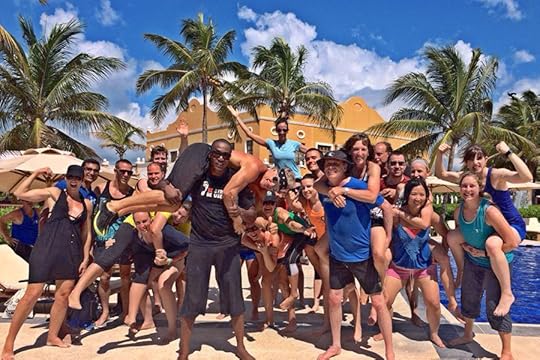
From PrimalCon Vacation Tulum 2014: Getting Manhandled by Darryl Edwards
Now that event logistics operate really smoothly after eight test runs, I have transitioned from a bit of a stresshead (“Has the caterer arrived yet? Are the cops gonna bust up our party?”–the latter quote is a joke….not!) to more of a participant who gets to soak in all the fun and educational opportunities. The messages you are about to read from our presenters are colorful to be sure, but there is nothing like meeting these folks in person and experiencing their magic and their positive energy first-hand. That said, here are some quick comments from each of our presenters slated for PrimalCon Oxnard—they’re hoping to meet you in person in September and so am I!
 Chef Rachel Albert: I can’t wait to meet everyone at PrimalCon this year! My presentation will cover my personal journey through breast cancer—including my experience with conventional, alternative, and integrative treatments, a stage IV diagnosis, a recurrence with brain mets (metastases), and how adopting a ketogenic paleo diet helped me reduce treatment side effects, feel stronger, get well faster, and clear the brain tumors. I’ll discuss topics such as how the diet can help with healing, what foods to eat and what foods to avoid, fasting, supplements, and dealing with cravings.
Chef Rachel Albert: I can’t wait to meet everyone at PrimalCon this year! My presentation will cover my personal journey through breast cancer—including my experience with conventional, alternative, and integrative treatments, a stage IV diagnosis, a recurrence with brain mets (metastases), and how adopting a ketogenic paleo diet helped me reduce treatment side effects, feel stronger, get well faster, and clear the brain tumors. I’ll discuss topics such as how the diet can help with healing, what foods to eat and what foods to avoid, fasting, supplements, and dealing with cravings.
Today, I’m nearly at the end of my battle with cancer. My internal organs, bones and brain are clear, and I’m doing some final oral chemo and meds to give me a clean score with my breast cancer. The doctors have been truly amazed at my progress, and I believe I have opened up some important eyes to the power of primal-aligned and ketogenic eating, and assorted alternative health treatments that complimented my more traditional medical treatments. I feel incredibly fortunate to be where I am today and also to have the opportunity to share my message with you. If you ever have any questions throughout the weekend, don’t hesitate to just come up to me and ask!
[Mark’s note: Rachel has been presenting at PrimalCon for the last three years. Most of us had absolutely no idea she was in a fight for her life during this period, because she was her usual high energy, super enthusiastic self pulling off these incredibly elaborate cooking shows that she took all day to prepare with her team of assistants. Her attitude and her resilience throughout her battle have been incredibly inspirational.
Rachel’s cooking shows have been a highlight at PrimalCon for sure, but we thought this fall that she should simply stand up and tell her story to everyone. This will happen Friday afternoon right before my talk, and I can say I absolutely don’t mind playing second fiddle to her in the ballroom on Friday’s agenda. What’s more, Rachel will be hanging out all weekend and you’ll have plenty of time to engage with her about shopping, cooking and food prep tips.]
 Tracy Barksdale: I have been attending PrimalCon since 2010, first as an attendee, then staff, then presenter, and then host of PrimalCon Austin 2013. This year I am back to Oxnard to hold one-on-one movement assessments. I am a bodyworker in Austin, TX, where I focus on natural movement to help relieve pain and discover optimal performance. Come find me during our breakout sessions for some movement assessment (squats, single leg stance, etc.) to address your mobility or stability strengths and weaknesses, and get some corrective strategies to improve.
Tracy Barksdale: I have been attending PrimalCon since 2010, first as an attendee, then staff, then presenter, and then host of PrimalCon Austin 2013. This year I am back to Oxnard to hold one-on-one movement assessments. I am a bodyworker in Austin, TX, where I focus on natural movement to help relieve pain and discover optimal performance. Come find me during our breakout sessions for some movement assessment (squats, single leg stance, etc.) to address your mobility or stability strengths and weaknesses, and get some corrective strategies to improve.
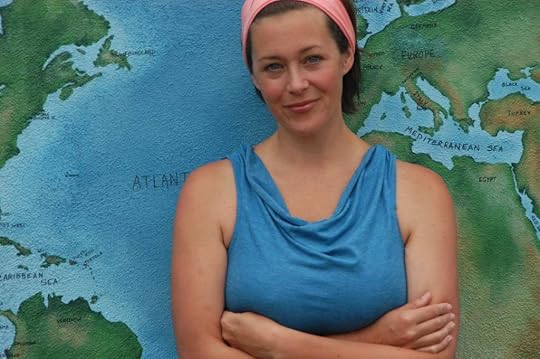 Katy Bowman: I’m super excited to be presenting a hands-on course on making your work environment better for your body. I’ll be leading an interactive seminar where we will cover the pros and cons of standup workstations, and how to integrate movement and variation into your workday—even if you work at a stodgy buttoned-up joint that frowns on standup desks and exercise balls. This seminar will be a sneak preview of a comprehensive online educational course that Mark and I have been working on in recent months. The title is “Don’t Just Sit There!” and it will include an informative eBook filled with pictures and instructional tips, a series of a dozen or so instructional videos, an audio recording of the eBook, and a detailed video conversation with Mark and I about the importance of adding more daily movement to our lives.
Katy Bowman: I’m super excited to be presenting a hands-on course on making your work environment better for your body. I’ll be leading an interactive seminar where we will cover the pros and cons of standup workstations, and how to integrate movement and variation into your workday—even if you work at a stodgy buttoned-up joint that frowns on standup desks and exercise balls. This seminar will be a sneak preview of a comprehensive online educational course that Mark and I have been working on in recent months. The title is “Don’t Just Sit There!” and it will include an informative eBook filled with pictures and instructional tips, a series of a dozen or so instructional videos, an audio recording of the eBook, and a detailed video conversation with Mark and I about the importance of adding more daily movement to our lives.
At PrimalCon, we’ll set up a mock office environment in the ballroom, and I’ll have an eager team of certified teachers from my nearby Restorative Exercise Institute to give you hands-on support. This workshop will help you optimize your own personal body alignment and also give you some great strategies to create a dynamic workstation and a day filled with movement and variation. See you soon! If you wanna get a quick grasp of what my mission is all about, visit moveyourdna.com.
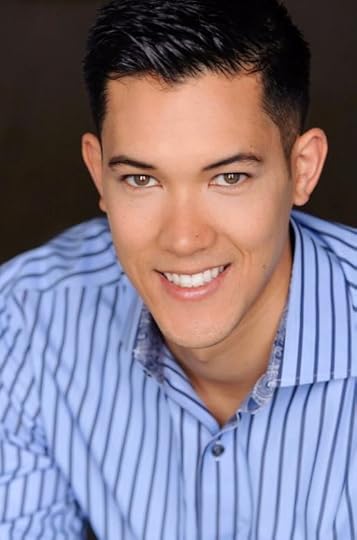 Tommy Brice, RPT: Hi, I’m Tommy Brice and I can’t wait to meet you at PrimalCon. I’m a Physical Therapist out of Milwaukee, WI and a graduate of Marquette University. I attained my bachelor’s degree in Exercise Physiology, a doctorate in Physical Therapy, and was a member of the Marquette men’s basketball team from 2004-2008. I’m a certified Performance Enhancement Specialist, and have recently been pursuing treatment through nutrition in the quest to treat the whole patient and help heal injuries from the inside out. My incorporation of a primal lifestyle has had a big impact on the patients in my clinic. Many of the key concepts are used to help facilitate a healthy recovery from various injuries and improved overall healing time.
Tommy Brice, RPT: Hi, I’m Tommy Brice and I can’t wait to meet you at PrimalCon. I’m a Physical Therapist out of Milwaukee, WI and a graduate of Marquette University. I attained my bachelor’s degree in Exercise Physiology, a doctorate in Physical Therapy, and was a member of the Marquette men’s basketball team from 2004-2008. I’m a certified Performance Enhancement Specialist, and have recently been pursuing treatment through nutrition in the quest to treat the whole patient and help heal injuries from the inside out. My incorporation of a primal lifestyle has had a big impact on the patients in my clinic. Many of the key concepts are used to help facilitate a healthy recovery from various injuries and improved overall healing time.
I will be available for injury assessments and treatment, hands on therapy using the Mulligan technique (a manual therapy technique that addresses musculoskeletal disorders with pain-free “repositioning” of joints), and assistance with active recovery through stretches or individualized therapeutic exercise programs. I’m also bringing a Midwest perspective that can be very helpful for global success of improved health and wellness. So if you have any aches and pains, reach out to me and we’ll work together to get your body where it needs to be!
 Angelo dela Cruz: Yep, I’m the guy tied with staff leaders Chris Adams and Tina Leaman, organizer Brad Kearns, and of course Mark, for the record of attending all eight PrimalCons! I’m excited to meet you in Oxnard this year to show you how to use movement and bodywork techniques to feel more powerful, fit, and full of energy every day. We’ll start our days with my custom-designed VitaMove session—it’s a little bit like yoga, mixed with TaiChi, mixed with Angelo. At the end you feel loose, warmed up and ready for action, but also relaxed and peaceful. I’ll also be available for one-on-one sessions to address pain or problem areas of your body with my unique and gentle healing and release techniques.
Angelo dela Cruz: Yep, I’m the guy tied with staff leaders Chris Adams and Tina Leaman, organizer Brad Kearns, and of course Mark, for the record of attending all eight PrimalCons! I’m excited to meet you in Oxnard this year to show you how to use movement and bodywork techniques to feel more powerful, fit, and full of energy every day. We’ll start our days with my custom-designed VitaMove session—it’s a little bit like yoga, mixed with TaiChi, mixed with Angelo. At the end you feel loose, warmed up and ready for action, but also relaxed and peaceful. I’ll also be available for one-on-one sessions to address pain or problem areas of your body with my unique and gentle healing and release techniques.
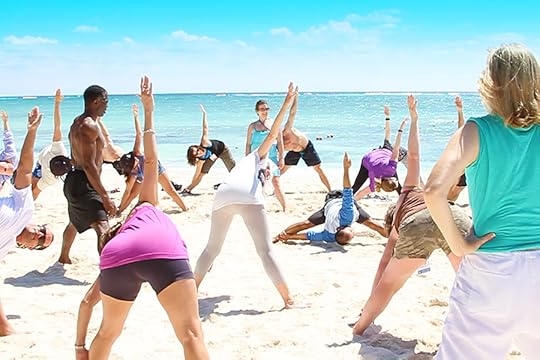
[Mark’s Note: Last month, I took my managing editor Brad Kearns to his first CrossFit Games in Los Angeles. We were watching the Muscle Up Biathlon event: a 400m run, 18 muscle-ups on the rings, 400m run, 15 muscle-ups, 400m run, and 12 muscle-ups—clock ticking, of course. As we stood on the running route (up stadium stairs, along ridge, and back downstairs to the rings at field level) Brad—a former pro triathlete and current masters track runner who just dropped a 59-second 400m time at age 49—remarked about how slow the participants were going on the 400m run laps...and how absolutely hulking ripped both the females and males were…
Yep, the competitors were pretty trashed and basically jog-walking the course before hitting another round of rings. I casually replied that muscle-ups are pretty difficult, and that they were also just midway through an entire weekend of separate competitions…Later in the expo area, Brad had the opportunity to attempt a muscle-up at a demo booth and struggled mightily to achieve a single muscle-up….Ouch!
The events at the Games are definitely no funny business. The CrossFit boilerplate “forging elite fitness” promotes the development of 10 disparate fitness skills (endurance, strength, power, speed, agility, etc.), but indeed the elite performers at the Games (and, it seems, the studs/studettes at your nearest CrossFit facility) seem to commonly be overloaded with muscle mass that’s way beyond functional.
Since I train to play rather than suffer royally at the CrossFit Games older-guys division, I’m realizing that my perspective about fitness is even broader than CrossFit’s. I marvel at the Games athletes and what they can do at their manufactured challenges, but I see no resemblance to the lithe Olympic sprinters I glimpse at the UCLA track now and then. Ditto for the NBA (and WNBA) specimens we see on TV. Yes, most are crazy tall, but they actually carry an impressively optimal amount of muscle mass for the disparate skills required on the court: the raw explosiveness to attack the rim all the way to the tremendous endurance needed to not only make it up and down court, but survive the lengthy season.
I’m on this tangent because I want you to be sure and watch Angelo’s Ninja Warrior videos ( 2014 demo ; 2012 demo ) and tell me you’ve ever seen anything better to embody well-balanced, functional, intensely primal fitness! Don’t forget this guy is on the other side of 40, and he’s fully booked most days helping others get fit instead of obsessively pursuing his own fitness goals.
Now, Angelo is a diminutive, soft-spoken guy. His Bruce Lee physique is well disguised in his comfortable clothes. In the fitness world populated by many greased up, inked up, scantily clad self-promoters, he’s refreshingly authentic and understated. Easy to overlook in a crowd at the CrossFit Games for example. But after eight PrimalCons, we have an incredible appreciation for the energy and the gifts this guy brings to the event. I could go on and on about Angelo and every other presenter, as well as the many amazing and inspiring guests that I’ve had a chance to get to know at PrimalCon over the years. But you have to experience the magic of PrimalCon first hand to really appreciate the superlatives thrown out here.]
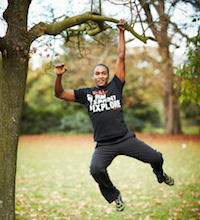
Darryl Edwards: Hi, it’s Darryl, The Fitness Explorer here. PrimalCon Oxnard will be my fifth consecutive appearance at PrimalCon! My mission at PrimalCon is to play from start to finish [Mark’s note: He is NOT kidding! This guy is a 24/7 energy machine!]. My sessions are for anyone who feels a little stale about the routine of running on the roads or hitting the gym, and might want to inject a little creativity into their daily routine. We are going to play like kids and reawaken that playful spirit that’s been suppressed by the hustle and bustle and confinement of adult life.

If we’ve played at PrimalCon before, I have some new tricks up my sleeve that you are going to love. And if you’ve never played at PrimalCon with me before, isn’t it about time? Check out some videos if you want to get a better grasp of what kind of fun we’ll have.
 Brad Kearns: I’m excited to attend my eighth PrimalCon! Mark refers to me as the PrimalCon organizer or PrimalCon director, typically addressing me on those terms when something goes wrong…Kidding aside, I will definitely take some credit for being there that day in January, 2010, when Mark and I parked on a dead end street in Oxnard and, navigating by Google maps, walked one block to discover one of the most beautiful park settings anywhere in the world, Oxnard Beach Park. We decided on the spot to create the first-ever PrimalCon a few months later.
Brad Kearns: I’m excited to attend my eighth PrimalCon! Mark refers to me as the PrimalCon organizer or PrimalCon director, typically addressing me on those terms when something goes wrong…Kidding aside, I will definitely take some credit for being there that day in January, 2010, when Mark and I parked on a dead end street in Oxnard and, navigating by Google maps, walked one block to discover one of the most beautiful park settings anywhere in the world, Oxnard Beach Park. We decided on the spot to create the first-ever PrimalCon a few months later.

The truth is, I made the decision to fire myself as organizer last year in favor of the much more focused and organized Arizona dynamic duo of Chris Adams and Tina Leaman, and Jaynee Higgott here at the PrimalCon headquarters office in Malibu. Now I get to focus on being a presenter! YES!
Being a former national champion professional triathlete and competitor on the global circuit for nine years, one of my favorite topics to discuss is how to cultivate the ideal mindset and disposition for peak performance in all areas of life. I reference my experience as a competitive athlete to get you motivated and deliver practical tips, because the athletic arena is a place where success and failure is exposed without excuses and nuances clouding the real story.
Keeping in the athletic spirit, I’m gonna impart my message to you in the context of a fun, active fitness rotation where we will learn the correct technique for the simple act of running. So we’ll have a little chat at the park about peak performance mindset, and then get out there on the beautiful grass fields and experience, maybe for the first time ever, what it feels like to run with beautiful, efficient, balanced technique. You’ll learn some fun drills and strategies to safely and gradually integrate actual sprinting into your exercise routine; since after all it’s one of the ten Primal Blueprint laws and about as primal as you can get!
Sound good? Then come on out to Oxnard this September and let’s have some fun at the park. Oh, I’ll also have some tricks up my sleeve in the ballroom as the emcee, until they turn my microphone off like they did at PrimalCon New York this summer….
 Leslie Klenke: This will be my third PrimalCon event, but my first time presenting. Eek! I guess I could be nervous, but I’m actually just excited to meet and connect with you all. This past year I’ve put all my time and energy into writing, designing, and now promoting my first book,Paleo Girl. For those of you unfamiliar with it, it’s a Paleo lifestyle guide for teen girls—but don’t let the description fool you. Paleo Girl has a ton of great information for everyone…and so will my talk at PrimalCon Oxnard.
Leslie Klenke: This will be my third PrimalCon event, but my first time presenting. Eek! I guess I could be nervous, but I’m actually just excited to meet and connect with you all. This past year I’ve put all my time and energy into writing, designing, and now promoting my first book,Paleo Girl. For those of you unfamiliar with it, it’s a Paleo lifestyle guide for teen girls—but don’t let the description fool you. Paleo Girl has a ton of great information for everyone…and so will my talk at PrimalCon Oxnard.
The takeaway from Paleo Girl as well as my topics of discussion at this event is that YOU are worth it. That you deserve to be happy, healthy, and full of love! Think of it as Paleo 2.0—the other key factors that are outside of the 10 Primal Blueprint Laws. I can guarantee everyone will walk away from our free choice gatherings feeling more connected, with a full heart, and a smile on their face. See you in September!
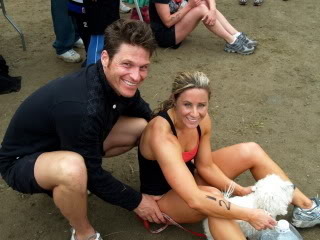 Adam and Vanessa Lambert: Let’s start the event off with a bang on Friday morning with our fitness rotations—our now world-famous fitness rotations! We can’t wait to show you safe lifting techniques on everything from lightweight PVC pipes to some real heavy duty weights if you’re inclined. We’re also going to cover the fundamentals of basic gymnastics and calisthenics, and present assorted other fun, safe, effective outdoor movements. We’re going to keep you pumped up and excited throughout our rotations, and we hope you’ll be inspired enough to incorporate some of what you learn with us into your own personal fitness routine. For more information on personal coaching or our upcoming Costa Rica adventure visit us at www.beethewellness.com!
Adam and Vanessa Lambert: Let’s start the event off with a bang on Friday morning with our fitness rotations—our now world-famous fitness rotations! We can’t wait to show you safe lifting techniques on everything from lightweight PVC pipes to some real heavy duty weights if you’re inclined. We’re also going to cover the fundamentals of basic gymnastics and calisthenics, and present assorted other fun, safe, effective outdoor movements. We’re going to keep you pumped up and excited throughout our rotations, and we hope you’ll be inspired enough to incorporate some of what you learn with us into your own personal fitness routine. For more information on personal coaching or our upcoming Costa Rica adventure visit us at www.beethewellness.com!
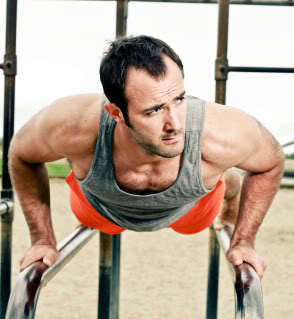 Brian Tabor: Hello. My name is Brian Tabor, and I am the owner of Strong Made Simple in San Diego, CA, as well as a MovNat Certification Team Instructor. I have a diverse background working with strength and conditioning programs (like the Navy SEALs Tactical Athlete Program), competing in Strongman competitions, as well as training all kinds of everyday fitness enthusiasts. In Oxnard, I’ll share my passion of empowering people to become strong, while keeping things as simple and effective as possible along the way. If I can help, support, or answer any questions about lifting, carrying, and getting strong, please don’t hesitate to come say hello.
Brian Tabor: Hello. My name is Brian Tabor, and I am the owner of Strong Made Simple in San Diego, CA, as well as a MovNat Certification Team Instructor. I have a diverse background working with strength and conditioning programs (like the Navy SEALs Tactical Athlete Program), competing in Strongman competitions, as well as training all kinds of everyday fitness enthusiasts. In Oxnard, I’ll share my passion of empowering people to become strong, while keeping things as simple and effective as possible along the way. If I can help, support, or answer any questions about lifting, carrying, and getting strong, please don’t hesitate to come say hello.
 Alessandra Wall: I’m a clinical psychologist and CrossFit certified trainer in San Diego, CA (Yes, I know, kinda random combo there…). In my practice, I specialize in treating the physical, emotional and cognitive challenges people are faced with when they attempt to make changes to their diet, fitness, and other life goals. I can’t wait to be back for a third round with the PrimalCon crew. Last September, after enjoying Tahoe as a participant, I submitted the feedback form (giving 10s all around!), and also suggested presentations on topics like how our psychology, thoughts and our histories affect our ability to engage in and stick with lifestyle/nutrition choices. The PrimalCon folks replied saying, “Great idea, can you suggest anyone?” Of course I suggested myself, and I was lucky enough to present on these topics at PrimalCon Vacation Tulum last March.
Alessandra Wall: I’m a clinical psychologist and CrossFit certified trainer in San Diego, CA (Yes, I know, kinda random combo there…). In my practice, I specialize in treating the physical, emotional and cognitive challenges people are faced with when they attempt to make changes to their diet, fitness, and other life goals. I can’t wait to be back for a third round with the PrimalCon crew. Last September, after enjoying Tahoe as a participant, I submitted the feedback form (giving 10s all around!), and also suggested presentations on topics like how our psychology, thoughts and our histories affect our ability to engage in and stick with lifestyle/nutrition choices. The PrimalCon folks replied saying, “Great idea, can you suggest anyone?” Of course I suggested myself, and I was lucky enough to present on these topics at PrimalCon Vacation Tulum last March.
I am really looking forward to Oxnard because I’ll get to sit down in small groups and talk about common personal and emotional barriers that inhibit us from adhering to our goals and desired behaviors. I’ll offer up real-life practical tips and simple steps that will help you realistically work through the things that stand in your way, so you can live life the way you mean to. I like to be upfront and direct about the issues and patterns that we seem to not talk much about, but are common barriers to success that we all face.
I promise you that we won’t get too uncomfortable or personal. After all, I can’t practice psychology in this setting, so I’ll be more like a coach getting you focused and motivated to make positive changes in your life—beyond the mechanics of what foods to eat and which to avoid. Oh, and I’ll also be hosting some early morning deep breathing and relaxation sessions for anyone interested in starting the morning off relaxed.
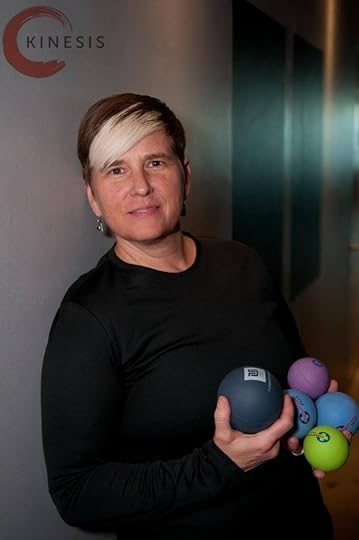 Dawn McCrory, DPT: Hi, I’m Dr. Dawn and I’m excited to meet you all in Oxnard this year! I’ll be presenting alongside my associate Coach Kimmie. Together, we’re co-owners of Kinesis Center for Integrated Living. Our presentation will focus on the Yoga Tune Up® therapy ball rolling session. Yoga Tune Up® is geared toward releasing the fascial restrictions and adhesions that ultimately lead to injury, pain, and reduced mobility. These adhesions are bands of painful rigid tissue that usually form in muscles, tendon and ligaments, can be caused from chronic tension or tightness, overuse and injuries. Adhesions can block circulation and cause pain, inflammation, limited mobility and affect overall performance and quality of life. The intention of our workshop is to leave you feeling healthier, more relaxed, stronger, and more balanced physically. While the PrimalCon physical activities are all calibrated to your particular fitness level and everyone is careful to not overdo it, by the time the event ends you may be a little stiff from all the fun activities. Our therapy ball sessions will be a welcome way to unwind!
Dawn McCrory, DPT: Hi, I’m Dr. Dawn and I’m excited to meet you all in Oxnard this year! I’ll be presenting alongside my associate Coach Kimmie. Together, we’re co-owners of Kinesis Center for Integrated Living. Our presentation will focus on the Yoga Tune Up® therapy ball rolling session. Yoga Tune Up® is geared toward releasing the fascial restrictions and adhesions that ultimately lead to injury, pain, and reduced mobility. These adhesions are bands of painful rigid tissue that usually form in muscles, tendon and ligaments, can be caused from chronic tension or tightness, overuse and injuries. Adhesions can block circulation and cause pain, inflammation, limited mobility and affect overall performance and quality of life. The intention of our workshop is to leave you feeling healthier, more relaxed, stronger, and more balanced physically. While the PrimalCon physical activities are all calibrated to your particular fitness level and everyone is careful to not overdo it, by the time the event ends you may be a little stiff from all the fun activities. Our therapy ball sessions will be a welcome way to unwind!
[Mark's Final Words: PrimalCon Oxnard 2014 is shaping up to be the best PrimalCon yet. I hope you'll join me and scores of other Primal enthusiasts from across the globe next month. I promise it will be a weekend you'll never forget.
To learn more about PrimalCon at large click here. To grab your tickets for PrimalCon Oxnard 2014 click here. See you there!]

Join Mark Sisson and Friends in Sunny Southern California this Sept. 25-28! Get Your Tickets for PrimalCon Oxnard 2014 Today and Finally Meet Your Tribe!




August 19, 2014
Smart Fuel: Mushrooms
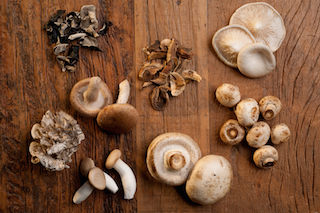 Neither plant nor animal, the mushroom usually gets lumped in with the former but genetically it’s closer to the latter. In fact, mushrooms and people are members of the same biological superkingdom, Opisthokonta, which excludes plants; we shared a common ancestor with fungus about 600 million years ago. But while mushrooms are an odd genre of organism, that’s nothing compared to what lies beneath and supports them. The mushroom is just the fruiting body of the underground network of fungal threads known as the mycelium.
Neither plant nor animal, the mushroom usually gets lumped in with the former but genetically it’s closer to the latter. In fact, mushrooms and people are members of the same biological superkingdom, Opisthokonta, which excludes plants; we shared a common ancestor with fungus about 600 million years ago. But while mushrooms are an odd genre of organism, that’s nothing compared to what lies beneath and supports them. The mushroom is just the fruiting body of the underground network of fungal threads known as the mycelium.
What’s so interesting about the mycelium?
It’s been called the “natural Internet,” transmitting data along its fibers using the very same neurotransmitters (serotonin, melatonin, and others) we mammals use to think thoughts. Other fungal transmitters, like psilocybin and psilocin from “magic mushrooms,” are similar enough to serotonin that they’re able to interact with our serotonin receptors and produce mystical, psychedelic experiences when we eat them.
It can break complex structures into simpler compounds. Certain mycelia have been shown to break down plastics and petroleum products, pesticides, and other contaminants into their constituent, less-toxic parts.
It’s enormous. A single mycelium network can cover thousands of acres, making it the largest single organism on Earth.
It participates in a kind of marketplace, extracting nutrients from the soil, transforming them, and using them to barter with plants for energy derived from photosynthesis. In this way, it supports the entire plant kingdom.
If you’re interested in this stuff, Paul Stamets is the go-to mycelium guy. His TED talk from a few years back is incredible, as is his book Mycelium Running: How Mushrooms Can Save the World.
Okay, okay. That’s interesting enough, but are mushrooms good to eat?
Well, if you asked representatives from the hundreds of human cultures across the globe that have utilized wild edible fungus, the answer would be yes. Humans have probably always eaten mushrooms, since mushrooms grow wild everywhere. And I do mean everywhere. The barren North African desert has edible fungi (desert truffles). Even Antarctica’s got fungi. No word on their edibility, though.
Mushrooms may not be the richest source of the better known micronutrients – your magnesiums, calciums, vitamin Cs, vitamin B12s, vitamin As – but they’re good sources of relatively rare nutrients like selenium, copper, and pantothenic acid. Fresh mushrooms also enjoy sunbathing, synthesize a good amount of vitamin D in response to it that we can utilize and absorb when we eat them. You can even buy some mushrooms from the store, lay them out on a plate in the afternoon sun for a couple hours, and they’ll synthesize vitamin D. Cool, huh?
But the real interesting properties of mushrooms lie in the compounds that don’t appear in FitDay or the USDA nutrient database. Many, perhaps most edible mushrooms contain substances with therapeutic, medicinal, or otherwise pharmacological effects. Let’s look at a few of them:
Shiitake
Shiitakes are denser, heavier, and higher in protein and iron than most other varieties. They’re also more expensive, but they’re probably worth it for the potentially therapeutic compounds:
L-ergothioneine is an antioxidant cytoprotectant, meaning it protects cells from oxidative damage. Some researchers think it might “represent a new vitamin” because it can only be obtained through diet. Shiitakes are by far the best source of L-ergothioneine.
Lentinan is a shiitake polysaccharide with anti-tumor and immune boosting effects. In people with depressed immune systems, lentinan can provide a needed increase.
Button
Don’t be fooled by its near paucity of mainstream nutrients. In animal models of arthritis, the lowly white button mushroom reduces the severity. It also elicits a heightened immune response, but only when co-administered with an immune insult (lipopolysaccharide/endotoxin). Simply feeding a mouse lots of white button mushrooms without giving it a reason to require an immune response has no effect (and rightly so). Also, high consumption of button mushrooms has been inversely linked to ovarian cancer in women.
Crimini/Portobello
Criminis are young, nubile portobellos. Portobellos are actually just old, crotchety criminis. And both criminis and portobellos are the same species – agaricus bisporus – as the white button mushroom. So everything mentioned in the last section applies here, too. As for portobellos, they’re famous for “replacing” meat in burgers and sandwiches, but I like portobello mushrooms much better with meat. How about instead of switching out the beef patty for a portobello, we replace the buns with the portobellos?
Chanterelle
Ah, man, nothing like a chanterelle sliced and cooked in some broth and butter. It can really make a man overlook the lack of solid research into the mushroom’s health benefits. Eh, some vitamin B12 that may or may not be inactive and preliminary in vitro indications of chemoprevention are good enough for me!
Porcini
Porcini mushrooms are invaluable when cooking Italian food, so it’s okay that there’s not much solid evidence for miraculous health benefits. They do, however, help hypertensive rats manage their blood pressure and improve the metabolic abnormalities often associated with hypertension.
Oyster
They appear on tree trunks, require delicate handling to avoid breaking, and may (big “may”) mimic nerve growth factor enough to stimulate the formation of new synapses. Oyster mushrooms also show anti-candida activity and contain a wealth of antioxidant compounds.
Lion’s Mane
I wrote about this already, but it tastes like lobster and could potentially improve your cognition, so I’m going to reiterate. Lion’s Mane usually comes dried and may reverse mild cognitive decline in the elderly, help people with nerve damage regenerate destroyed nerves and regain their ability to walk, and act as a nootropic in healthy people.
As you can see, every mushroom people have looked into seems to be good for us. And there are some commonalities that keep appearing: some interaction with nerve growth factor, cognitive function, immune function; a host of antioxidant compounds. Great in omelets, perfect alongside a steak, and ideal for boosting the immune system.
A few tips:
Cook them. Fungal cell walls are made of chitin, the same “fiber” found in insect carapaces. Chitin can be difficult to digest, but heat breaks it down, making the mushroom easier to digest and unlocking the nutrients. A sautéed mushroom also just tastes really, really good.
A real simple, foolproof way to cook mushrooms (any mushroom I’ve come across) is to slice them and saute in butter and/or olive oil for about five minutes, or until they begin to soften and darken. Then you add a few dashes of Worcestershire sauce, a few dashes of balsamic vinegar, some red wine, or maybe some good beef or chicken stock. Anything that you can reduce will work. Reduce that down over low heat until the sauce gets syrupy. Sprinkle sea salt and cracked black pepper to taste.
I suggest checking out the dried mushroom aisle of an Asian grocery. Those are great to add to soups and stews (no rehydration required), and there are just so many interesting kinds to choose.
And go to the local farmer’s market. There’s usually a mushroom guy there with dozens of varieties that you’d never find in a grocery store. He can tell you what they taste like, how to cook them, and what to expect from them because he most likely cultivated them. Make friends with the mushroom guy.
Wild edible mushrooms abound, but so do poisonous varieties. To avoid getting sick, contact your local Mycological Society; they’re also everywhere. They’ll set you up with guided shroom-hunting tours with local experts, so you know what to look for and what to avoid. You might also check Meetup.com for a mushroom hunting group near you.
If you want to grow your own, I suggest checking out the Shroomery forums. Its members focus on cultivation of psychedelic species, but they’re also very knowledgeable about edible cultivation. There’s also a good board dedicated to mushroom hunting and proper identification where you can provide photos and a description (following a template provided by the regulars) and get expert opinions on whether the mushroom you picked is deadly or delicious.
I hope this post has piqued your curiosity and your appetite. It’s long overdue that we start incorporating more mushrooms into our Primal way of eating.
What’s your favorite type of mushroom and how do you like to cook it?
Join Mark Sisson and Friends in Sunny Southern California this Sept. 25-28! Get Your Tickets for PrimalCon Oxnard 2014 Today and Finally Meet Your Tribe!




August 18, 2014
Dear Mark: New Parent Issues, Corn, and Pain’s Purpose
 For today’s edition of Dear Mark, we’ve got a three-parter. First, I draw on my experiences as a parent and observer of the new generation of Primal parents to tackle a big topic: how to maintain a Primal mindset as a new parent beset by all the crazy, often unreasonable demands of modern parenting. It’s not as bad or as hard as you think. Next, I discuss whether or not corn tortillas are really an issue for someone who enjoys eating them for her 80/20. Are they as problematic as other grain-based foods? Finally, I explore the purpose of pain.
For today’s edition of Dear Mark, we’ve got a three-parter. First, I draw on my experiences as a parent and observer of the new generation of Primal parents to tackle a big topic: how to maintain a Primal mindset as a new parent beset by all the crazy, often unreasonable demands of modern parenting. It’s not as bad or as hard as you think. Next, I discuss whether or not corn tortillas are really an issue for someone who enjoys eating them for her 80/20. Are they as problematic as other grain-based foods? Finally, I explore the purpose of pain.
Let’s go:
Hi Mark,
I’ve been searching your archives for some advice for new parents – and I’ve found a ton of great advice on breastfeeding, co-sleeping, and babywearing. I am sold on those, as well as the need to eat primally in the first year. However, I’m also interested in your perspective on adapting the Primal Blueprint principles to the new parent lifestyle – the sleep deprivation, the sense of isolation so many new parents deal with, the anxiety-producing competitive nature of parenting these days, as well as the general stress of protecting a tiny new person from harm (and the even greater stress when they finally do, inevitably, get hurt). I can see all that stress (even in moms without PPD or PPA) definitely impacting the best way to implement Primal principles in practice with a new baby. A Dear Mark answer or Definitive Guide would be so much appreciated! Thanks so much for all you do!
Kelly
Yes, the diet aspect of pregnancy and early parenthood is fairly straightforward: you just make and eat the food. Finding time to cook can be hard, especially early on, but the act of cooking and eating itself isn’t any different from before. Same with baby wearing, co-sleeping, and breastfeeding. These are things you just do (well, the last one can be trickier than many people expect) or do not.
But having precious sleep snatched from you? Feeling the prying eyes of parent peers judging the way you’re holding your kid, how big your kid is for his or her age, whether he can talk or walk or crawl or make eye contact? The loneliness when you’re the first of your friends to take the plunge into parenthood and it’s just you and your spouse entering into this whole new world without any real guidance save for a few blogs and books? The crushing realization that the fate and well-being of your progeny rests entirely in your hands? Those are dynamic and totally new for all of us. There are no easy solutions.
Sleep: First of all, the disrupted sleep of a new parent is (hopefully) a temporary situation – a couple weeks of really messed up sleep, a couple months of spotty sleep, and several more months of “merely” suboptimal sleep. This isn’t a decade of staying up late watching bad TV deep into the night. You’re doing what you have to do. You have purpose. You’re not drifting. Although I haven’t seen any research to corroborate this, I suspect that infant-induced sleep deprivation isn’t as detrimental to your health as other kinds.
That said, you can work with your situation. Scale back on your workouts; they’ll be less effective and even too stressful if you’re going on little sleep. Eat fairly clean Primal; sleep deprivation will make you more insulin-resistant than usual. Eating cassia cinnamon (say, in your coffee) on a regular basis can counter some of the sleep loss-related insulin resistance. I’m sure you’ve heard this a thousand times, but it’s true: sleep when the baby sleeps. And don’t forget, biphasic sleeping may be more common and normal than most of us are led to believe.
Isolation: Yeah, it’s tough. We by and large no longer have “the village” or the tribe or even the extended family at arm’s reach to help out and shoulder some of the load. That’s a huge deficit in the modern nuclear family set-up. I’m not sure it can be replaced, not completely. But we don’t have to be completely isolated.
If you’re the first of your crew to have a kid and you worry about falling off the face of the earth, well, don’t. Friends that are actually your friends won’t shun you. Sure, you can’t go out to the clubs or that one great dive bar with the best jukebox that still lets people smoke inside (even though you don’t smoke, it’s worth it), but you probably don’t want to do that stuff anymore anyway. You can still have dinner parties, go on hikes and camping trips, hit your favorite restaurants, have picnics, go to concerts and festivals. You can still do most of the same things you guys used to do. Just do them with a baby hanging on your arm/breast/hip. You’d be surprised at how agreeable most infants are to new situations if you just bite the bullet and take them places. It’s not that bad. Besides, if you’re co-sleeping, baby wearing/holding, and breastfeeding, chances are your kid’s going to be very easy going, comfortable, and secure in new situations.
Too many new parents assume the worst will happen if they take their infants out in public. They imagine exploding diapers, bodily fluid geysers bursting from orifices, endless crying, and hateful looks from everyone around them. That doesn’t really happen much. It’s probably all you can remember of those childless days when you’d be waiting in the Trader Joe’s checkout line with a bawling hellion three spots back that you swore was screaming directly into your soul. But there was that time at Whole Foods when a two month old slept on her dad’s chest two spots back from you, never making a peep. Or the four month old in the bookstore just staring wide-eyed agog at everything, totally silent, from the baby carrier. You never even noticed because we only notice the loud ones. They’re not all like that. Most of them just sail under the radar. Yours probably will too.
Check out Meetup.com and search for “parenting” or “kids” or “children” groups near you. There are lots of other people in your same predicament.
Competition: The opposing mom’s eyes narrow as she scans your child for characteristics that hers has surpassed or has yet to reach. You hear her brain whirring and running the numbers until she concludes that yes, her child is more advanced. “Oh, she’s not walking yet? Kayleigh was doing ballet at 10 months.” The obsession with “milestones.” False politeness, too-cheery smiles, subtle digs. The tendency to assess another person’s child like a pig at a county fair. “He’s got some meaty haunches, doesn’t he?” It’s so strange. I suggest you ignore it. Don’t get wrapped up in the competition, and don’t take anything to heart. Most parents hate that stuff, too, and only do it because they think they’re supposed to care. Be the one who stands up and refuses to engage; others will follow.
Some kids walk earlier than others. Others talk earlier. Your kid might exclusively crawl until he’s 13 months and then suddenly start walking. He’ll be no worse off than the kid who walked and talked at 10 months. Maybe even better, as all that crawling will establish neuromuscular efficiency and good shoulder and arm strength. Whatever course it takes, they’ll develop on the schedule ordained, or maybe suggested, by their physiology.
Worry: Newborns are fragile, helpless things that depend entirely on you. But then, after a few months, they’re a little less fragile. They can hold their heads up and make faces at you. They might even start to smile. And the first time they flip over onto their back, their oversized bald head leading the way directly into the floor, you cringe and prepare for tears – but they just laugh. That’s when you realize kids are tougher than we think. After all, you survived the skinned knees, the broken bones, the dodge balls to the face. They will too. And once they get hurt and bounce back, your stress levels will drop as you realize it’s not so bad after all.
How about the scary outside world teeming with sexual predators and leering kidnappers? It’s actually not. Most of those sexual predators either urinated in public or consensually slept with their 16 year old girlfriend when they were 18, and the vast majority of child abductions occur at the hands of someone the child knows – like a family member. The world is safe.
But here’s my question. What specifically is wrong with corn itself? And even if I keep corn tortillas within an 80/20 framework, what is that corn doing in my body that is potentially harmful?
I see, yes it’s carby, yes it’s a grain (and not a vegetable!), and certainly primal man did not eat it. But I have scoured the internet for in-depth information from the paleo community on corn, and mostly I turn up criticism of corn syrup, which is a different beast than corn. It’s like we’ve got great explanations on beans and soy, industrial oils and gluten, but then we get to corn and say, “Yeah, that’s a grain. And HFCS is bad.”
I know you get a lot of mail, but I hope you’ll consider answering this one on a podcast or in a blog post! Thanks for your time.
Jamey
I’m not very worried about corn tortillas, for several reasons.
The corn used to make them undergoes nixtamalization, or lime (calcium hydroxide, not the citrus) treatment. This makes corn more nutritious, creates a more favorable protein profile, increases the bioavailability of niacin/vitamin B3, and imbues the tortilla with a decent dose of calcium (from the lime) that you can actually absorb. Nixtamalization allowed preindustrial native Americans to survive and even thrive on a largely corn-based diet. If you try such a diet without nixtamalization, you end up with pellagra – severe vitamin B3 deficiency. Nixtamalization does reduce the phytochemical content of corn, but that’s what blueberries are for.
Zein, the corn prolamine that’s been likened to gluten, probably isn’t as bad as gluten. Few people even report issues with corn, let alone zein, and in people with confirmed allergies to corn, zein isn’t even the most common offending protein. Unless you have a definite reaction to corn, I wouldn’t worry too much.
They’re often vehicles for delicious, nutritious passengers, things like avocado, diced onions, pickled carrots, chiles, carne asada, carnitas, as well as more exciting/unique (at least to gringos) items like cow tongue, goat face, and chapulines (crickets). Don’t just judge a food’s worth by its weakest, most disagreeable link. Consider the strong points, too. I’d argue that all that nutrient density outweighs the presence of corn. Tacos everyday? No (unless you’re visiting Mexico). But quality tacos with quality ingredients surrounded by quality corn tortillas are an excellent justification for the 80/20 rule.
When I get a headache, I take a nap. I always wake up feeling better, no pills needed. I suspect that Grok had limited access to painkillers, and allowed his body to heal on its own by resting. Could there be a benefit to being mindful of pain as a cue to take it easy as opposed to dulling it away with analgesics?
Juan
People born without the ability to feel pain – congenital insensitivity to pain, or congenital analgesia - have to take special precautions throughout life. They can feel warmth, but not extreme temperatures. If they reach into a pot of boiling water to retrieve a dropped spoon or bite the tip of their tongue off, it doesn’t hurt. But their flesh still burns and their tongues still need healing. They can’t really depend on their nervous system to assess threats and determine damage. They have to learn how to avoid injury and then consciously remember the lessons in real time. That’s tough. Without early intervention (and cautious, watchful caretakers), people with congenital insensitivity to pain suffer terrible injuries and a reduced life expectancy.
So yes, pain is important. Pain is helpful. Pain is information. Avoid it, but don’t always dull or ignore it.
Thanks for reading, everyone. Let me know what you think in the comment section!
Not a Subscriber? You Are Missing Out. Subscribe for Free Today and Instantly Get 8 Primal eBooks and So Much More!




August 17, 2014
Weekend Link Love – Edition 309
 Episode #32 of The Primal Blueprint Podcast is now live, and I’m answering reader questions about statins, CoQ10 depletion, the nature of hunger, and much more. If you have any ideas for future podcasts, please let us know by using the blue “Submit a Question” button in the sidebar!
Episode #32 of The Primal Blueprint Podcast is now live, and I’m answering reader questions about statins, CoQ10 depletion, the nature of hunger, and much more. If you have any ideas for future podcasts, please let us know by using the blue “Submit a Question” button in the sidebar!
Research of the Week
Most French wines contain plasticizers.
When it comes to polyunsaturated fats, the animal-based ones – DHA, EPA, and AA – are far more oxidatively stable than the plant-based ALA and linoleic acid.
Interesting Blog Posts
Science-Based Medicine admits that antibiotics are a big problem.
The effect of varying your walking speed on type 2 diabetes.
Media, Schmedia
Antiperspirants change your pit flora and probably make you smell even worse.
Also, go ahead and avoid antibacterial soaps while you’re at it. They cross the placenta, show up in fetal blood, produce antibiotic resistant bacteria, and just make things worse overall.
Everything Else
We should totally hang more.
Why, specifically, are Americans so stressed out?
Seven hours of sleep a night isn’t going to cut it if you’re active.
The value of shopping at farmer’s markets.
Man leaves lucrative career, becomes surfing, photographing, paleo-eating nomad. “If it was hard, I wouldn’t be doing it.”
Take a break. A real one.
Recipe Corner
Smoky venison stew would probably work with beef or bison, but do try to get your hands on some deer flesh.
Zucchini “pasta” with creamy “alfredo,” spiced meatballs, and crispy artichoke hearts. Ignore the quote marks and just make it.
Time Capsule
One year ago (Aug 17 – Aug 23)
Slacklining – My New Obsession – Slacklining is an incredibly fun way to get fit and strong. You should try it.
Sheltered: Missing the Primal Power of Nature – You’re missing out, I’m missing out, the human race in general is missing out.
Comment of the Week
The cold, dead hand of Puritanism still hovers over America.
- Get back to work, Harry.
Like This Blog Post? Dig Deeper with Primal Blueprint Books and Learn How You Can Reprogram Your Genes to Become Leaner, Stronger and Healthier




August 16, 2014
Primal Egg McMuffin
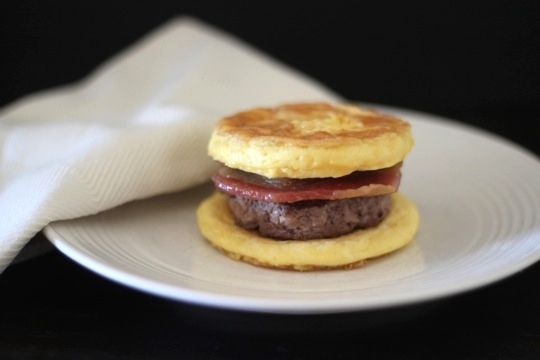 Some mornings, nothing hits the spot like a breakfast sandwich. Skip the fast food drive-through and doughy English muffin and instead make yourself this wholesome protein-packed Primal Egg McMuffin.
Some mornings, nothing hits the spot like a breakfast sandwich. Skip the fast food drive-through and doughy English muffin and instead make yourself this wholesome protein-packed Primal Egg McMuffin.
Eggs, with no other ingredients added, can easily be made into “English muffins” by using a biscuit cutter as a mold. Add a basic burger (seasoned like breakfast sausage, if you like) and a strip of bacon and breakfast is served.
A pound (450 g) of ground meat and a dozen eggs will make 6 sandwiches. If you’re making just one or two breakfast sandwiches, plan to use about 2.5 ounces (70 g) of ground meat, 2 eggs and 1 strip of cooked bacon for each sandwich. However, the sandwiches keep fairly well in the fridge for a few days so don’t hesitate to make a bigger batch for grab-and-go eating in the morning.
Servings: 6
Time in the Kitchen: 30 minutes
Ingredients:
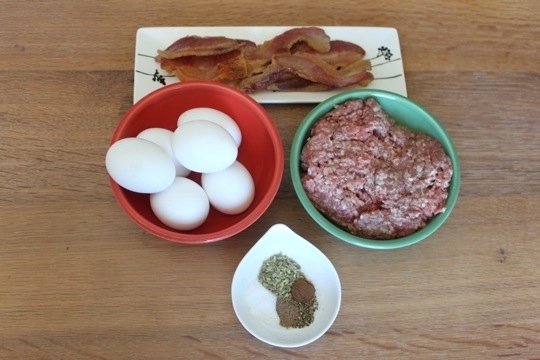
1 pound ground beef or pork (450 g)
1/2 teaspoon salt (2.5 ml)
1/2 teaspoon black pepper (2.5 ml)
1 to 2 teaspoons fennel seeds (5 to 10 ml)
1/4 teaspoon ground nutmeg (a pinch)
1/2 teaspoon ground allspice (a pinch)
6 strips of cooked bacon
12 eggs
Instructions:
In a bowl, mix together the ground meat and salt, black pepper, fennel seeds, nutmeg and allspice. Form the meat into 6 patties weighing about 2.5 ounces/70 g each. Set aside.
Heat a well-oiled skillet over medium-low heat. Set a 3 1/2-inch (9 cm) biscuit cutter in the skillet. Whisk one egg and pour the egg into the biscuit cutter. As the egg cooks, gently scramble it with a small rubber spatula or other utensil, making sure to scrape up/pull back the bottom and let more of the raw egg hit the hot pan (sort of like cooking an omelet).
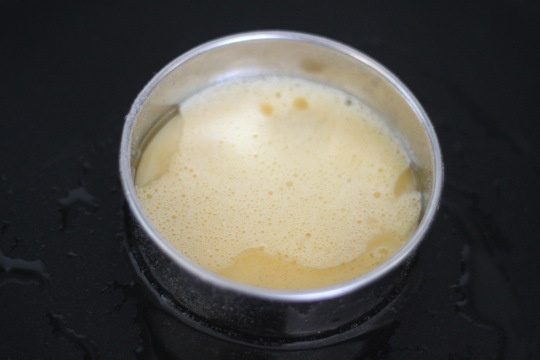
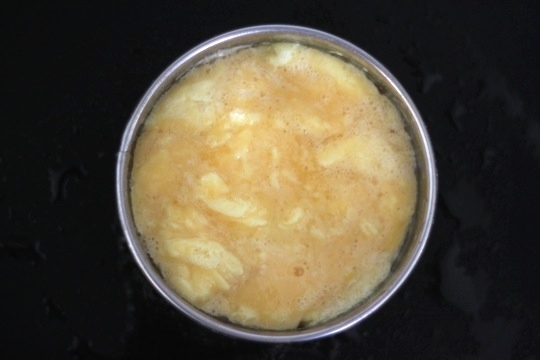
Once the egg is about 1/2 way cooked, stop scrambling and leave the egg alone so it can firm up on the bottom. Run the spatula around the edge of the biscuit cutter to loosen the egg and gently lift the biscuit cutter. Flip the egg patty and cook for 1 or 2 minutes more. Repeat this process until you have enough egg “muffins” for your sandwiches.
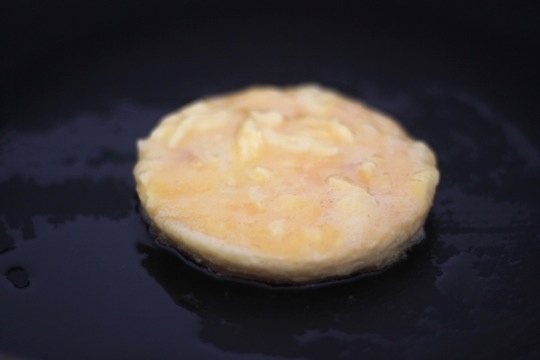
In the same skillet, raise the heat slightly and cook the meat patties for 3 to 5 minutes a side until done.
To make a sandwich, layer the egg, burger and bacon and top with another egg.

Not Sure What to Eat? Get the Primal Blueprint Meal Plan for Shopping Lists and Recipes Delivered Directly to Your Inbox Each Week




Mark Sisson's Blog
- Mark Sisson's profile
- 199 followers



